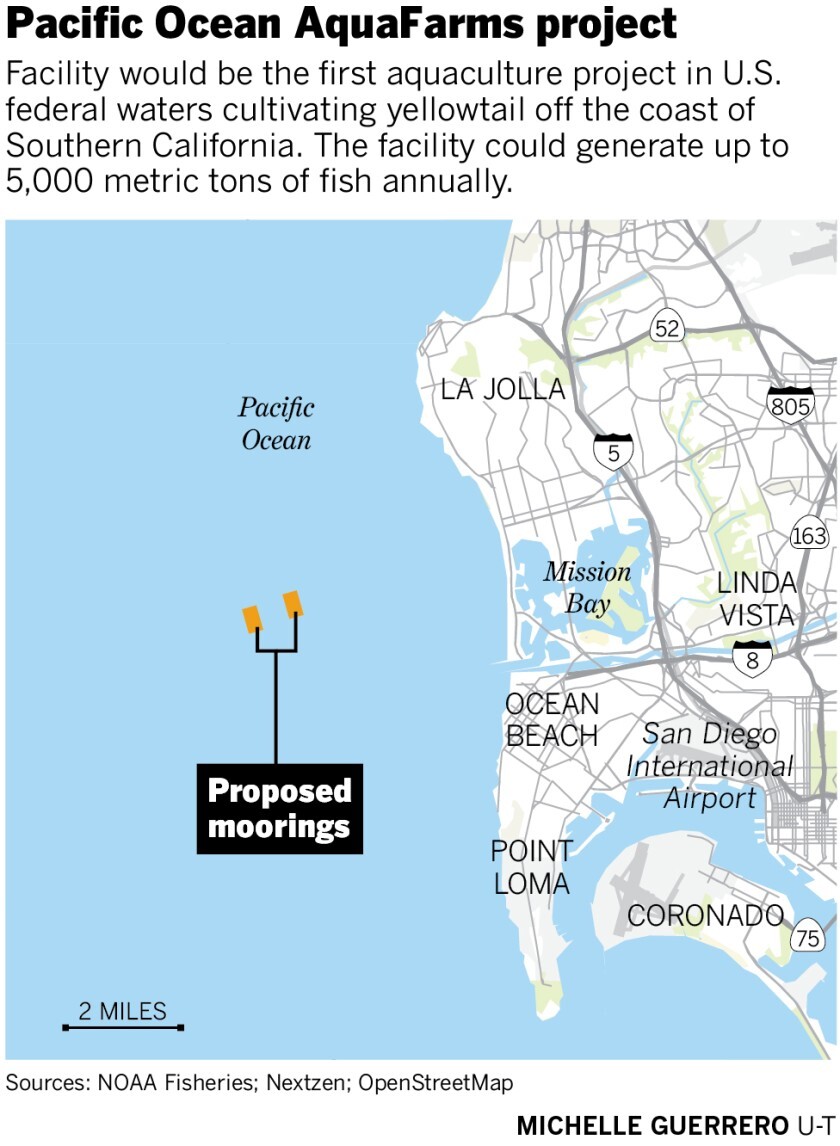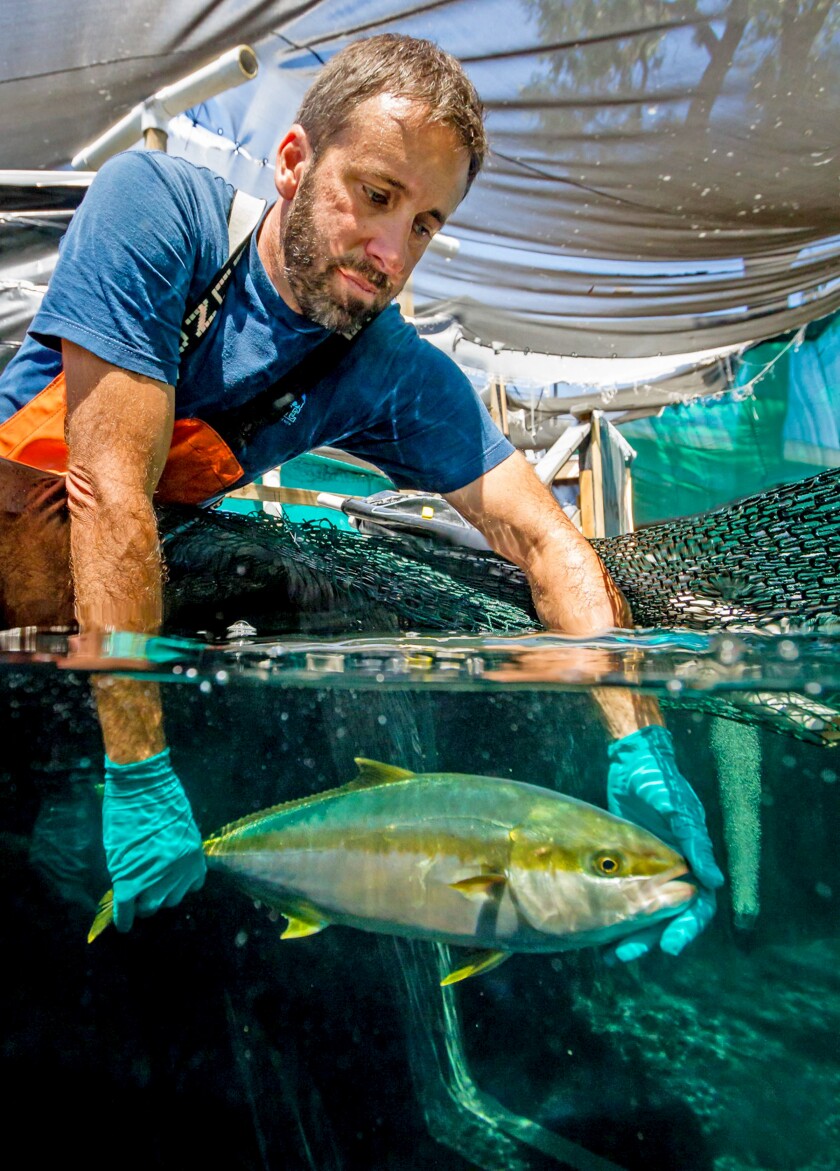A local research institute has proposed a new fish farm in the ocean off Bird Rock and Mission Bay, and some in the local fishing industry are unhappy about the prospect.
The proposed Pacific Ocean AquaFarms, a venture of the Hubbs-SeaWorld Research Institute and Long Beach-based investment group Pacific6 Enterprises, aims to produce 5,000 metric tons of yellowtail fish annually in federal waters four miles off the coast, according to a federal permit application submitted Sept. 9.
The project would create economic opportunities and provide a local source for a fish that is now mostly imported, backers say.
The National Oceanic and Atmospheric Administration, serving as lead agency, published a notice of intent to prepare an environmental impact statement for the proposed development, “a commercial-scale finfish aquaculture facility,” according to NOAA Fisheries spokeswoman Kate Goggin.

The farm’s proposed location alarms John Law, an independent commercial fisherman who has been fishing outside Mission Bay since the mid-1970s.
“I’ve been fishing this little patch of water where they propose to put this fish farm every year of my life and I don’t want it to go away. I don’t want them to put a Walmart on top of my grocery store,” he said.
Law has opposed the location of the project since first hearing of it years ago. “I’m not an opponent of fish farms,” he said. “My opposition to this farm has only been its location.”
Not only would the fish farm hurt Law’s livelihood, he said, but “it’s a bad fit for the community.”
Residents in the La Jolla and Pacific Beach areas should be wary, he said: “It’s going to change their view and quite possibly affect their water quality, the condition of their beaches.
“It’s a big industrial farm; it’s 1,000 acres. It’s not a small thing.”
Law sent an email to alert the Bird Rock Community Council of the proposed location.
Community Council President John Newsam said Law would be invited to speak during the group’s next meeting Tuesday, Oct. 6.
“I don’t have more input than that at this stage, but anything that might impact our ocean is, of course, a concern to an ocean-edging community like ours in Bird Rock,” Newsam said.
Several community group leaders in Pacific Beach and Ocean Beach said they weren’t familiar enough with the proposal to comment.
The farm’s location also worries Pete Halmay, a sea urchin diver and president of the San Diego Fishermen’s Working Group, a nonprofit representing local anglers on issues that “affect all the fisheries of San Diego,” according to Halmay.
The group is preparing a “pretty detailed explanation of why [the project] doesn’t work,” Halmay said. “It hurts fishing, it hurts the environment, it hurts everything. There really isn’t much of an upside to it.”
Halmay said “you need aquaculture in poor countries, where food is limited. But that’s not what this thing is about; it’s about expensive yellowtail that you don’t need. There’s plenty of fish.”
The Pacific Ocean AquaFarms project, Halmay said, would “destroy our fish marketing; we’re not going to be able to sell our local fish.”
“That’s just the economic argument,” he said, adding that the influx of farmed fish would pollute the water and that materials used may injure whales and other marine mammals. “This is just the tip of the iceberg,” he said. “Almost everything about this project is bad.”
But Don Kent, chief executive of Hubbs-SeaWorld, said he hopes the proposed farm will give “the San Diego seafood industry, as well as the commercial fishermen that want to be involved in it, an opportunity to have a complementary source of income that will help revitalize the seafood infrastructure down on the port, as well as provide jobs for ... people who work on the water.”

Federico Rotman of the Hubbs-SeaWorld Research Institute with a young adult California yellowtail at the organization’s Mission Bay laboratory.
(Courtesy)
The selected location, Kent said, “meets all the oceanographic conditions that we’re looking for: depth profile, sandy bottom, that sort of thing.”
San Diego has many such locations, he said, but the Navy, expressing concerns about possible interference with its research and training operations, limited the area to the 1,000-acre “polygon” proposed for the farm.
Addressing concerns of reduced water quality, Kent said preliminary studies show that “if you site the farms appropriately, with the right depth and current flow, there is no degradation of the water quality, there’s not deposition of materials.”
He also said “that’s something that needs to get dealt with as part of the [environmental review] process.”
However, Ernie Prieto, who runs a sportfishing operation out of Oceanside and fished out of Mission Bay for 17 years until 2018, said he’s concerned about “the privatization of previously accessible fishing waters. Any proposed fish farm placed over ‘live bottom’ … where fish congregate, feed and propagate their species, will cause a lack of fishable space.”
The project application states that a “preliminary alternative” site is being considered about four miles off Long Beach.
Law hopes the alternate location will be chosen, saying it has “already been used for aquaculture, which to me would be the right path because you have a site that’s already been vetted and used and passed through the court of public opinion.”
Prieto said he “would love to see [the farm] go to Long Beach. That area’s already been set up as a fish farm. That makes more sense, to put a farm where there used to be a farm.”
Kent, however, said the San Diego location “is closer to our operation,” noting that he’d like to see “the economic benefits be realized in San Diego.”
Hubbs-SeaWorld, based at Mission Bay and with contacts with area universities, is a “center for research and innovation here, and I think this is a complement to that,” he said.
Goggin said NOAA is accepting public comments through Oct. 26 about the project’s “potential to affect the human environment, means for avoiding, minimizing or mitigating those effects, the preliminary reasonable range of alternatives and any additional reasonable alternatives.”
NOAA also will hold two public webinars Oct. 14 and 16. Details for commenting to NOAA and joining the webinars are at bit.ly/fishfarmcomment.
Public comments will “inform preparation” of the draft environmental impact statement, Goggin said, which will then be released for public review.
With the environmental study and construction, it could be up to five years before the farmed fish are ready for consumption.
Matt O’Malley, executive director and managing attorney for San Diego Coastkeeper, a nonprofit environmental group, said his organization is “closely tracking this project, as we have been tracking attempts to industrialize our ocean and coastline with factory finfish farms and cages.”
“Massive finfish projects such as the one proposed would have significant harmful impacts on water quality, wildlife and habitat, marine mammals, native fish stocks (including disease transmission) and our Marine Protected Areas here in San Diego,” O’Malley said. “San Diegans don’t want their oceans and coastline to be industrialized and destroyed with profit-driven projects such as this.”
San Diego Coastkeeper is “positioned to fight this project,” he said. “We support investing in rebuilding native fish stocks and our local fishing community toward a sustainable fishing future for San Diego.”
— San Diego Union-Tribune staff writer Deborah Sullivan Brennan contributed to this report.
"local" - Google News
September 27, 2020 at 10:05PM
https://ift.tt/3cMp74B
'Plenty of fish' in the sea? Local anglers want to throw back proposed fish farm off San Diego coast - pbmonthly.net
"local" - Google News
https://ift.tt/2WoMCc3
https://ift.tt/2KVQLik
Bagikan Berita Ini














0 Response to "'Plenty of fish' in the sea? Local anglers want to throw back proposed fish farm off San Diego coast - pbmonthly.net"
Post a Comment